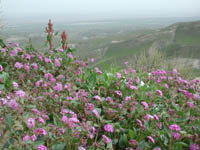This article needs additional citations for verification .(January 2021) |
| Abronia pogonantha | |
|---|---|
 | |
| Scientific classification | |
| Kingdom: | Plantae |
| Clade: | Tracheophytes |
| Clade: | Angiosperms |
| Clade: | Eudicots |
| Order: | Caryophyllales |
| Family: | Nyctaginaceae |
| Genus: | Abronia |
| Species: | A. pogonantha |
| Binomial name | |
| Abronia pogonantha | |
Abronia pogonantha is a species of flowering plant in the four o'clock family (Nyctaginaceae) [2] known by the common name Mojave sand-verbena. It is native to California [3] and Nevada, [4] where it grows in the Mojave Desert, adjacent hills and mountains, and parts of the San Joaquin Valley in the Central Valley. [2]
This is an annual herb producing prostrate or upright glandular stems to about half a meter long. [5] The petioled leaves are mainly oval-shaped and up to 5 centimeters long by 3 wide. The plant blooms in an inflorescence [6] of many white or pink flowers, each with a tube throat up to 2 centimeters long. [7] The fruit is a winged, heart-shaped body about half a centimeter long. [7]
